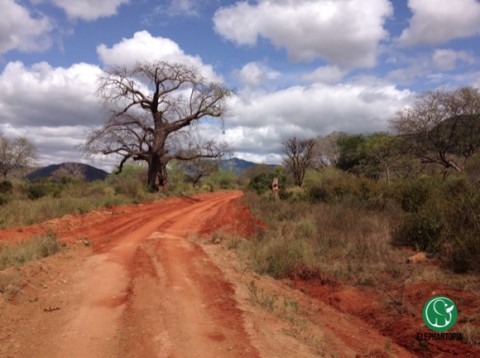On the Road of the Ivory Trade in Kenya
“When you kill an elephant, you are killing a Kenyan,” Isaac Ngala told me on a sunny afternoon in Emali, Kenya, a small town on the A109 highway that is filled with truckers carrying cargo from across east Africa to the coastal port town of Mombasa. How many of those trucks were carrying ivory tusks from slaughtered elephants? While we were there, a news update came on the TV stating that just that day 200 tusks were found in a shipment in Mombasa. That’s 100 elephants. And that same week in Masai Mara, 117 elephant carcasses were found. Could these be related? It’s almost too obvious.
This past June, I travelled to East Africa to learn firsthand about the elephant poaching crisis. My first stop was Tsavo East. Stopping in Voi, another transit town on the illegal ivory trade route, I said a silent prayer for the elephants and the people of the community that a harmonious future for both could somehow be found; that peace and unity could once again thrive. Once in the park, the iconic red-dusted elephants were everywhere, family groups of 20 or more grazing together. The picture seemed almost perfect.
At our campsite, I had the pleasure of meeting rangers from Care for the Wild who were stationed there, on missions to de-snare traps set up by poachers. These rangers told me that this year they expect a higher rate of poaching since the rains were so short. The crops that locals plant for their sustenance would not be plentiful, so they were preparing themselves for people coming into the park illegally hunting game meat and, if possible, elephants, to earn an extra buck.
The David Sheldrick Wildlife Trust stockades for the older elephant orphans who are being slowly re-introduced to the wild are also located in this park. I had the opportunity to visit Naipoki and Rombo, two elephants I personally have been supporting for the last few years. Naipoki, now 3 years old, looked healthy and happy munching on her favorite evening snack with her two best friends. Rombo, an elephant victim of poaching, is a little older. His fiesty spirit can be seen in the few bumps and scratches on his skin. The keepers told me that he is getting more physical with the elephants, as he grows older as a male elephant, playfully sparring with other young males, testing to see who is the strongest.
Joseph, a keeper who has been working for DSWT for the last 14 years, was beaming over these orphans. The love he has for these animals was completely evident - to him, these elephants deserve freedom and family, life and a future, like anyone else in Kenya. My driver, John, had never been close to elephants before. So I invited him to come in and meet Naipoki and Rombo. The experience for him was life-changing. He could not believe he was touching an elephant (he decided Rombo was a bit too big, and so declined coming closer). He learned about the poaching crisis and was able to meet first hand the casualties of the ivory war. He left a changed Kenyan.
Driving through Tsavo West was epic. The landscape was so dramatic, red dirt and enormous mountains. But something was missing…the animals. Once, 6-7,000 rhinos roamed the park. Today there are 100 left, most of them living in a rhino sanctuary with only 12 in the wild. Elephants were seen few and far between, hiding in bushed areas. It was evident from the animals that this park had been hit hard by poachers. The road between Tsavo and Amboseli is also perilous - tourists are only allowed to travel at 8am or 2pm each day with a convoy from KWS due to the violent activity from poachers who wait in ambush for travelers on the road between the parks.
Yet amidst the reality of the poaching crisis in East Africa, we arrived at the haven for elephant advocates: Amboseli National Park. The elephant families here are so beautiful, and plentiful. It was an honor to see these families, knowing that the beloved Echo once led her family on these very grounds. Some of my most memorable scenes are pictured below: elephant calves blissfully playing with their family, giant bulls grazing in the swamplands, elephants napping, mud-bathing, dusting and just living in the wild, where they belong, without a care in the world. Not an hour went by that KWS, Amboseli Trust for Elephants, or IFAW weren’t driving by, observing the animals and patrolling the park. Here, the elephants are protected under watchful surveillance.
Back in Nairobi, I spent a day visiting the DSWT stockades - once at noon for their feeding and again that evening to see them getting put to bed. During the lunch feeding, there was a playful spirit among the orphans. That evening for bed, while some continued their perky antics, others exhibited an air of dolefulness. As beautiful as it was to see these elephants, these moments brought home the grim reality as to why these elephants are here in these stockades.
Elephantopia’s mission is to Save Elephants and Build Community. This trip to Kenya confirmed the importance of both these actions. Every 15 minutes an elephant is killed for it’s ivory. That’s 96 elephants a day. If nothing is done to stop this horrific butchery, elephants will be extinct within our lifetime. And the answer to saving elephants begins with community. Many locals I met explained the tragic consequences to their rural communities from elephants raiding their crops. Or worse yet, some had never even had the opportunity to even see an elephant because the cost to enter the national parks is exorbitant compared to their income. But meeting people like Isaac and Joseph, Kenyans with a heart for conservation, because of their personal investment, paints a hopeful picture of a future where elephants and humans live together in harmony. And that’s what Elephantopia’s mission is about.
But we can’t do this alone. We are looking for people like YOU and your friends to JOIN THE HERD with us. We need to create a herd of people from around the world who are dedicated to saving elephants together in community. Here are three easy ways to get involved:
1) SIGN THE PLEDGE - say no to ivory and ask others to join you
2) CARE FOR KAVALA - the cost to care for an orphaned elephant is approximately $1,000USD a month. Be a part of caring for Kavala, a victim of the ivory trade, by donating $10, $20, $50 or more today.
3) MARCH WITH US - this October 4, 2014, have your voice heard and join the March for Elephants! Elephantopia is sponsoring a march in Houston, TX. There are over 50 other countries around the world marching with us. Find a city near you (or better yet, start a march in your area!)








I am trying to find a list of cities for the walk on 10/04/2014.
Thank you
Renee
March locations can be found here: http://www.march4elephantsandrhinos.org
[…] Our Founder and Director, Elizabeth Chitwood, visiting with rangers in Kenya’s Tsavo East National Park. You can read more about their work On The Ivory Road here. […]
[…] Kenya for three weeks and observe elephants from Tsavo East to Amboseli (you can read all about it HERE). While camping in Tsavo East, I met rangers who work for Care For the Wild. These rangers work […]